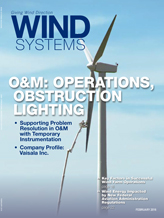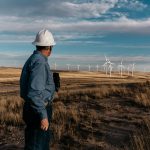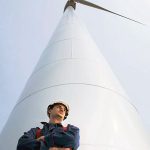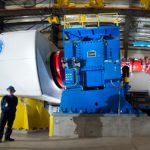The organization of how things get done between the OEM, subcontractor, and owner can be quite different from wind farm to wind farm, but no matter what type of organization is in place or how old the site is, the main goal of wind farm operations is to have all of the turbines running anytime there is wind. Here, you’ll find several points that may help your team improve your wind farm’s operation.
Minimizing Downtime During Wind
An attempt to schedule all repairs and services during low to no wind or when the power has low value would be ideal. During transition periods of no wind, grid drops and direction changes can cause nuisance faults and unnecessary losses in production.
Wind Power Plants Versus Industrial Plants
The main difference between a wind power plant and other types of industrial plants is the fact that we cannot predict or control our power source — the wind.
Another difference is that it is not feasible for the O&M side of the industry to visit each piece of machinery every week, especially if there are a large number of wind turbines in your plant spread out over miles of terrain. For other industries, the ability to visit all of your machinery as frequently as you like is the standard. Note that substandard work concerning the quality of care of your wind farm will quickly show in your turbines’ power production.

Comparing Machine Outputs on a Bimonthly or Monthly Basis
This is an easy way to see if all your machines are functioning as they should. The turbines will typically follow a trend, such as turbine A performing better than turbine B.
Monitoring systems such as SCADA have become an expected part of the wind turbine. But even so, proper and safe operations happen out in the field, not from a remote computer terminal. Remote resets can cause hazardous conditions and a loss of life or machine. Rules must be followed to prevent an unnecessary tragedy when using remote communication systems. At a minimum, the technician in the field should be in control of the task at hand.
Employees
The recommended number of maintenance employees depends on the size of the facility along with the type of machines in use.
In the 1980s, it was typical for wind farms with machines rated between 65 and 150 kW to run two-manned crews for each group of 80 to 130 machines. With the larger machines and taller towers, this is no longer possible. Today, some sites are not manned, but when work is commenced, it is usually with a minimum of two technicians for safety.
Management must weigh the cost of having additional personnel versus having a turbine turned off for extended periods of time due to manpower shortages.
The dangers of having too few trained personnel may also hamper your operations. It is safer to be slightly heavy on trained personnel than light when it concerns your operations. It is also recommended that more than one member of your team share critical knowledge needed to run them, or you may find yourself in a difficult situation should the one key employee leave.
Record-Keeping
Keeping a record of services is a required part of operations. It helps document work you do and allows you to find trends with the equipment. Of course, properly completed paperwork is always appreciated after the fact. Don’t overburden your technicians with numerous forms to fill out. Keep it simple. Their time is best spent with the machines.
Inventory and Tools
I recommend keeping the minimum amount of inventory on site, but this really depends on the supply pipeline. Someone near Los Angeles has quicker access to most parts and tools than someone in the far reaches of North Dakota.
Additionally, most companies provide their techs with the tools, however, this is not a requirement. It’s a good idea to take care of these tools, especially if your company is willing to provide them for you.
Driving Company Trucks
You must consider where and how to park on a wind farm. Good habits are formed by parking your vehicle facing into the wind and far enough away from areas of turbine work to prevent damage or injury. The wind can rip back an unsuspected door or a tool can hit a parked truck.
High Wind/Foul Weather Days
As long as it’s safe, these are great days to perform technical training, fabrication, and rebuilding of parts, site cleanup, turbine noise and vibration checks, thermal checks (during high winds only), and any other work that has fallen behind that does not require that the turbines be shut off.
Welding
Welding in the field requires care and consideration of the vegetation and wind. Fireguards are always recommended and should be required. If it is windy, reschedule the work. If you cannot reschedule, place multiple fireguards and water trucks, water down the area where sparks will be, and stay alert.
In high winds, it is highly recommended that you reschedule welding and heavy grinding work to a day with less wind.

Climbing
All climbing requires you to wear and use safety equipment that ties you to the turbine at all times. Some of today’s machines are large enough to work in without climbing gear in certain sections of the machines. In these situations, there is no danger of falling, and climbing gear is optional. Most all other areas in these machines require that you stay tied in at all times.
Climbing below another climber places you in danger of falling objects. It is best to wait for the first climber to reach the top or close a section door before starting your climb. And if they drop something, you can bring it up.
Dangers exist when working on top of a machine with climbing gear. It’s crucial to keep all lanyards and loose clothing away from all shafts and motors and to treat all of these items as live or moving objects at all times, even when they’re not.
Climbing should not be done if you are working alone.
Electrical Work
Electrical work requires training, especially since electrical work on metal structures adds additional safety concerns. Remember to follow standard electrical safety rules such as working with one hand while inside a cabinet with live power. Do not allow another worker to come in contact with you should you not be at the same potential. Whenever it is possible, work with the power off. Proper lock-out and tag-out procedures are essential. Unless the worker is trained to do so, no electrical troubleshooting should be allowed and no panels should be opened. Resetting faults and turning off a problematic machine should be the extent of electrical work for the untrained worker.
Other unsuspecting hazards are in the controller. Although the machine may not be online, there may still be potential on the power conductors. There has been an increase in power electronics used in wind. These devices require extra precautions as there can be stored power or voltage potential with minimal current still on the circuit. This means that even if the turbine is turned off, but is still with power, it may be unsafe to touch. So, “off” doesn’t mean off or that it’s safe to touch until the disconnect for that circuit is shut off. With some turbine manufacturers, “off” does not necessarily mean anything is turned off until the pad mount transformer is off.
The same may be true if uninterruptible power supplies (UPS) are in use. It is critical to only work on electrical equipment after it has been confirmed with a test meter that the power is off.
Moving Objects
Dangerous areas on turbines that consist of rotating objects include (but are not limited to) the blades, rotor, low-speed shafts, high-speed shafts, yaw systems, cooling fans, yaw motor cooling fans, hydraulic pumps, nacelle cover activators, hydraulic rams, and other pinch points.
Hoisting Systems
Most dangers with hoisting tools are to the person on the ground. It’s best to send up multiple loads of tools instead of one extremely heavy load. Don’t overload your tool bags, and don’t stand directly below a tool being hoisted. It’s recommended that you watch the load as it is attached and moved to ensure you know if something falls and where.
Communications Between the Top and Bottom of the Turbine
Radios are the recommended form of communication from top to bottom. Cell phones are also handy. The days of yelling up and down the tower are over, for the most part, due to the increased heights of the new wind turbines. It is impossible to hear anyone from atop a 60-meter or 200-plus-foot tower with any wind blowing.
Standing in the drop zone of a wind turbine that is being worked on may be hazardous. The person on top of the wind turbine is in the most danger concerning work, so he should be in charge of the repair or service procedure. This includes calling off the repair for safety concerns. The ground man is expected to support his efforts by gathering the requested tools and supplies and possibly controlling the wind turbine functions as requested.
There are many aspects and skills required to run a wind farm safely and productively. You could easily do crane work, electrical work, and stand out on the front of a hub all in one day’s work. That’s what makes working on a wind farm so exciting and fulfilling. I recommend open communication between all of the operations and maintenance team. They will be much more productive and safer when knowledge is shared.
































